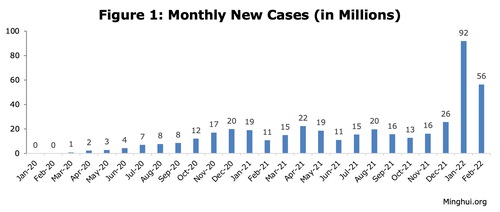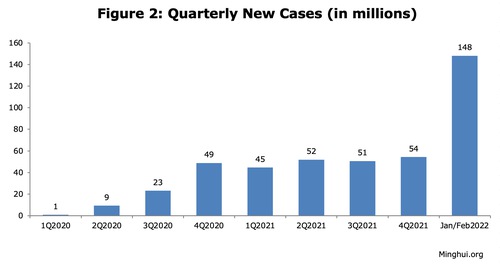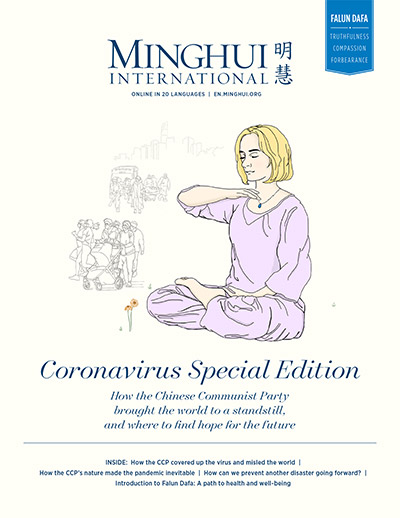(Minghui.org) The Covid-19 pandemic has been raging around the world since it first broke out in late 2019. Despite various measures to battle the disease, new cases continue to grow, even after many people have been fully vaccinated and boosted against the virus. New variants such as Omicron seem to evade vaccine protection and continue to infect people.
This article aims to discuss whether alternative solutions are available to curb the pandemic.
New Cases Continue to Emerge
Figure 1 shows the monthly new cases from January 2020 to February 2022. The new monthly cases increased steadily each month in 2020, from 0 million in January and February to 20 million in December. January 2021 reported slightly fewer new cases (19 million), followed by a sharp decline in February (11 million). The rest of the 2021 data shows several peaks and valleys, with December recording the most cases (26 million). Entering 2022, January saw a record 92 million new cases, followed by 56 million in February.
 Figure 1: Monthly new cases in millions (data source: Worldometers.info and statnews.com)
Figure 1: Monthly new cases in millions (data source: Worldometers.info and statnews.com)
Worth noting was that the U.S. Food and Drug Administration approved the first Covid-19 vaccine on August 23, 2021. While there were fewer new cases in September, October, and November that year, new cases suddenly surged in December and the first two months of 2022, which suggest limitations of vaccination in curbing the pandemic.
 Figure 2: Quarterly new cases (data source: Worldometers.info and statnews.com)
Figure 2: Quarterly new cases (data source: Worldometers.info and statnews.com)
A similar trend was also seen with quarterly new cases. The first quarter of 2020 recorded a total of 1 million cases, and the second quarter saw 9 million cases. The third quarter of 2020 had 23 million cases, and the fourth quarter reported 49 million cases. All four quarters in 2021 reported relatively stable amount of cases, ranging from 45 million in the first quarter to 54 million in the fourth quarter. But the cases suddenly surged in 2022, with the first two months alone reporting 146 million cases.
This shows that numerous interventions, ranging from lockdowns to vaccinations, have limited effect on defeating the disease, especially newer variants.
An Unanswered Question
To understand the viral infection process, a human challenge study was conducted and the result was published in a February Nature Medicine paper titled “Safety, tolerability and viral kinetics during SARS-CoV-2 human challenge in young adults.”
A year-long clinical trial approved by the UK government, the study was a collaboration between the UK Vaccine Task Force, Imperial College London, and the virology research company hVIVO. In this experiment, 36 volunteers aged between 18 and 29, without evidence of previous infection or vaccination, were inoculated with coronavirus.
About half of the participants (18) were not infected despite being injected with the virus. The other half that did become infected were asymptomatic or showed mild symptoms. Demographics between the infected and uninfected participants were similar. Further study is needed to answer why half of the participants didn’t get infected at all. Any insights gained from such study would help us understand the disease better.
The Limitation of Lockdown and Vaccination
Studies in Applied Economics published an article in January 2022 titled “A Literature Review and Meta-Analysis of the Effects of Lockdowns on COVID-19 Mortality.” The authors found that lockdowns have had little to no effect on COVID-19 mortality.
“More specifically, stringency index studies find that lockdowns in Europe and the United States only reduced COVID-19 mortality by 0.2% on average. SIPOs [shelter-in-placeorders] were also ineffective, only reducing COVID-19 mortality by 2.9% on average. Specific NPI studies also find no broad-based evidence of noticeable effects on COVID-19 mortality,” wrote the authors. “In consequence, lockdown policies are ill-founded and should be rejected as a pandemic policy instrument.”
“Public-health officials ruined many lives by insisting that workers with natural immunity to Covid-19 be fired if they weren’t fully vaccinated,” wrote Marty Makary, a surgeon and professor at John Hopkins, in a January Wall Street Journal article titled “The High Cost of Disparaging Natural Immunity to Covid.”
“But after two years of accruing data, the superiority of natural immunity over vaccinated immunity is clear,” he continued. “By firing staff with natural immunity, employers got rid of those least likely to infect others. It’s time to reinstate those employees with an apology.”
Researchers from Harvard published an article in the European Journal of Epidemiology in December 2021 titled, “Increases in COVID-19 are unrelated to levels of vaccination across 68 countries and 2947 counties in the United States.” The authors found no discernible relationship between the percentage of fully vaccinated population and new COVID-19 cases.
Günter Kampf from University Medicine Greifswald published a paper in The Lancet in November on this topic with the title of “COVID-19: stigmatising the unvaccinated is not justified.”
He wrote, “There is increasing evidence that vaccinated individuals continue to have a relevant role in transmission. In Massachusetts, USA, a total of 469 new COVID-19 cases were detected during various events in July, 2021, and 346 (74%) of these cases were in people who were fully or partly vaccinated, 274 (79%) of whom were symptomatic.”
A similar situation happened in Germany, where 55·4% of symptomatic COVID-19 cases in patients aged 60 years or older were fully vaccinated individuals. “It is therefore wrong and dangerous to speak of a pandemic of the unvaccinated,” he concluded.
(To be continued)
Views expressed in this article represent the author's own opinions or understandings. All content published on this website are copyrighted by Minghui.org. Minghui will produce compilations of its online content regularly and on special occasions.
Category: Wuhan Virus








